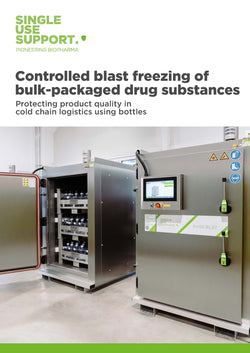How blast freezing affects the quality of bottled drug substance: Test results and insights
For some time now, scientists have been discussing the challenges associated with freezing biopharmaceuticals in sterile bottles – especially the risk of cryoconcentration and how it might affect product quality. So, we decided to take a closer look and set out to conduct in-depth studies to gain a deeper understanding and address this critical challenge in bottle freezing. What did we find? Find out in this article.
Understanding cryoconcentration in freezing bottled drug substances
What did we want to look at and why? To increase product stability and shelf life, biopharmaceutical substances are frozen to different ranges of sub-zero temperatures. This helps decrease microbial growth, and slow down undesirable chemical reactions like oxidation. However, this seemingly simple method to maintain product quality also carries risks: macromolecules can denature due to cold, or pH-shifts can occur, caused by what is known as freeze or cryoconcentration.
Cryoconcentration mostly occurs as bulk-scale freezing concentration. It leads to the formation of an ice front that grows from the outside-in, thereby creating a concentration gradient. This macroscopic phenomenon can cause protein degradation and undesirable changes in the chemical milieu, with all the known side effects.
In our study, we aimed to investigate precisely this bulk-scale cryoconcentration in bottles that are frozen in a conventional blast freezer. Our focus was on the substance
- Distribution – visually highlighted by dye intensity
- pH-value changes, and
- Conductivity to obtain a comprehensive picture of this uneven distribution.
What were materials and methods used?
To simulate the complex processes during freezing, we used a surrogate solution: a sucrose solution (5%), with 100 mM NaCl, as well as monosodium and disodium phosphate, dissolved in 80 liters of tap water. The pH was adjusted to 6.60. To make the concentration distribution visible, Naphthol Blue Black dye was added.
The bottles were filled with 1.6 liters of this surrogate solution and equipped with thermocouples positioned in immersion sleeves located in the center of the bottle to monitor the initial freezing behavior.
After a blast freeze run, ten bottles (from the top and bottom levels of the arrangement) were selected for further analysis.
The bottles were cut into five 3cm long pieces. Samples were taken from the bottom, middle, and top slices (see Figure 1). These were collected in 50mL Falcon tubes for subsequent analytics. pH and conductivity measurements were performed, and dye intensity was measured at a wave length of 620 nm.

Figure 1: Overview of methods and materials: Bottle preparation (left), drill hole position (middle) and exemplary drilled slice from sample C4, top, mid slice (right)
What were the results?
Formation of ice in bottles
Important for our understanding of cryoconcentration in bottles were the observations regarding ice formation: The freezing process starts from the bottom, followed by the formation of a freezing front on the sidewalls, with ice crystal growth progressing from the walls inwards and upwards. This led to a generally higher VIS-absorbance (visible light absorbance, i.e., dye concentration) and conductivity in the lower and middle sections of the bottles. Figure 2 clearly illustrate the relative change in dye concentration, with deviations of over 80% in some areas.

Figure 2: Change in dye concentration for top and bottom level, concentration in % in relation to the initial concentration
Phase transition time
The freezing performance showed a quite large span in the phase transition time:
- For water it varied between 3 hours 30 minutes and 5 hours 15 minutes
- Surrogate solution required between 3 hours 12 minutes and 5 hours 0 minutes
What do the outcomes say about bottle freezing?
Cryoconcentration per container type
The study confirms that cryoconcentration in bottles is more pronounced compared to bags in plate freezers. The main reason for this is the inhomogeneous heat transfer into and out of the container. This is mainly due to the geometry of the container. Bottles are more bulky than single-use bags that have smaller water columns to freeze.

Figure 3: Top view on iceberg formation, sample C3 top level
The “Volcano Effect”
The phenomenon we observed – where the liquid core is pushed out of the bulk solution and forms an "iceberg" (see Figure 3) – is a clear sign of the so-called Volcano Effect. Imagine how the ice grows from the walls and bottom, pushing the remaining liquid solution towards the center and upwards. Since the solutes (like our dye and salts) remain in the liquid water and are not incorporated into the ice crystals, they concentrate in this remaining liquid core. When this core is further pushed upwards and eventually freezes, areas of extremely high concentrations are created on the surface or in the upper part of the bottle – similar to a volcanic eruption where material from the inside is brought to the surface. This significant concentration inequality can severely impact product quality and integrity.
RoSS.BLST vs. conventional blast freezing: What makes the difference?
Unlike conventional blast freezers, RoSS.BLST uses a controlled freezing protocol tailored to the container format and product type. By managing the freezing rate and airflow distribution, it minimizes the formation of uneven ice fronts and reduces the risk of cryoconcentration. In our tests, RoSS.BLST showed significantly more uniform dye distribution and conductivity values across bottle sections — indicating better solute preservation and product integrity.

Figure 4: Visualization of the volcano effect in bottles occurring in uncontrolled freezing, compared to consistent distribution in controlled freezing.
Why controlled blast freezing matters for manufacturers
Controlling the freezing rate lets us tailor temperature profiles to each product, helping to smooth out the phase transition and cut down on unwanted concentration effects. All these insights have gone directly into the development of RoSS.BLST – Single Use Support’s controlled blast freezer. It’s especially well-suited for freezing drug substances in large formats and brings a range of benefits to manufacturers, including a modular, space-saving design.
For biopharma companies working with high-value drug substances, RoSS.BLST offers a validated, scalable solution to freeze in bottles without compromising quality. It’s not just about freezing - it’s about preserving product integrity, batch consistency, and regulatory confidence.
[[download-1-email-detailed]]
Study performed in collaboration with Management Center Innsbruck and Single Use Support.

Download paper
Controlled blast freezing for bulk-packaged drug substance
Freezing drug substances in bottles can be challenging, especially when it leads to product instability or cryoconcentration. Controlled blast freezing is key to preserving product quality. But efficient drug manufacturing requires more: Container closure integrity, smart use of facility space, sustainability and process flexibility are essential for scaling and streamlining operations. Read on to explore what really matters when freezing bottles.
